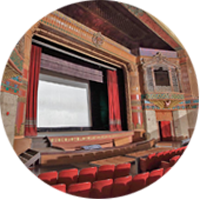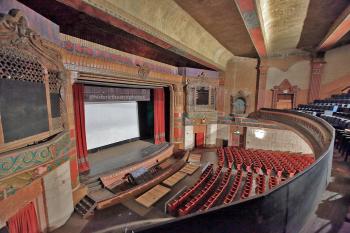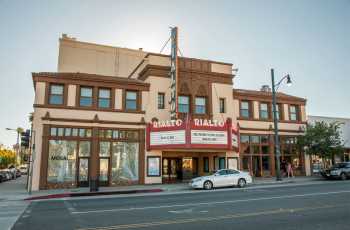

<< Go Back up to Region ‘Los Angeles: Greater Metropolitan Area’
| Follow Mike Hume’s Historic Theatre Photography: |  |
 |

Architect: Lewis A. Smith
First Opened: 17th October 1925 (100 years ago)
Status: Currently in use by a church group
Website: www.mosaic.org/south-pasadena 
Address: 1023 Fair Oaks Ave, South Pasadena, CA 91030 
The Rialto opened in October 1925 and was designed to showcase both movies and vaudeville. It was one of the last theatres designed by noted architect Lewis A. Smith (Smith also designed the ever-popular Vista Theatre on Sunset Blvd), and is executed in a mix of styles including Egyptian and Spanish Baroque, however is mainly Moorish Fantasy.

 Detailed Information
Detailed InformationOriginally announced as a 1,600-seat house, the Rialto ended-up with around 1,200 seats. According to the National Park Service the current capacity is 1,143. When it opened in 1925, its policy was to run feature length movies and present vaudeville on Thursdays and Saturdays in addition to the movie. The Rialto was a try-out stage for vaudeville produced by Fanchon and Marco. As an alternative to vaudeville, at times live drama was also presented, again in conjunction with a movie screening,

The auditorium is decorated with bright colors and stenciled features, with mythical creatures in some key locations: harpies support the organ grilles from below and, located centrally above the proscenium, is a gargoyle with glowing red eyes – lit-up before, during and after performances. A Batchelder tile drinking fountain is located in the lobby.
In addition to the theatre’s features enabling it to present full-scale productions (dressing rooms, fly tower, 30ft deep stage, large orchestra pit) the building also includes retail store fronts on either side of the entrance, plus independent apartments above the retail spaces.
From the 1930s the Rialto was operated by Fox West Coast Theatres, and it was at this time that the current Art Moderne neon marquee replaced the original marquee. According to the National Park Service, for about ten years, beginning in the middle of the 1930s, the Rialto had an interesting distinction: each year when the Academy Awards were announced for the best picture of the year, it was already playing at the time at the Rialto. The theatre suffered a backstage fire in 1938 necessitating closure for several months. After reopening neither vaudeville nor live drama played again at the Rialto.
In the 1960s operations turned-over to Mann Theatres. Notable organ concerts were given by George Wright playing the 2 manual, 10 rank Wurlitzer pipe organ. The organ was later removed as a result of a fire in 1968, when water hoses had to be aimed at one of the organ grilles to help put out the fire.
Landmark Theatres took over in 1976, and in 1977 South Pasadena citizens circulated petitions to save the Rialto from demolition to make way for a parking lot. The theatre was designated a Historic Cultural Monument in 1977 and added to the National Register of Historic Places in 1978. By the 1990s Landmark was planning to multiplex the theatre. The multiplex plan never came to fruition and in 2007 Landmark Theatres closed the Rialto due to dwindling ticket sales, the last screening being “The Simpsons Movie”.

In 2014 the theatre was purchased by Los Angeles developer Izek Shomof with the intention of bringing live entertainment back to the Rialto. In mid-2017 it was announced a 20-year lease had been signed by Mosaic Church.
The exterior of the theatre was restored in 2020, in a deal with the tenants which saw the owner take responsibility for restoring the exterior and leasing the retail units at street level, and the tenants taking responsibility for the interior. Scaffolding covering the exterior came down in June 2020 and new neon was installed onto the marquee and vertical sign in November 2020.
The Rialto is no stranger to the movies and is most notable for its prominent appearance in La La Land (2016)  . Amongst many other movie appearances the Rialto has also been seen in Kentucky Fried Movie (1977)
. Amongst many other movie appearances the Rialto has also been seen in Kentucky Fried Movie (1977)  , A Nightmare on Elm Street 4 (1988)
, A Nightmare on Elm Street 4 (1988)  , The Player (1992)
, The Player (1992)  , and Scream 2 (1997)
, and Scream 2 (1997)  .
.
 Movie, TV & Music Video Appearances
Movie, TV & Music Video Appearances
 . The Rialto is seen both inside and out as the movie theatre where Mia and Sebastian go to see “Rebel Without A Cause”.
. The Rialto is seen both inside and out as the movie theatre where Mia and Sebastian go to see “Rebel Without A Cause”. . The exterior of The Rialto is used for the “Stab” movie premiere although the interiors are shot at a different theatre: The Vista in Silver Lake.
. The exterior of The Rialto is used for the “Stab” movie premiere although the interiors are shot at a different theatre: The Vista in Silver Lake. . The Rialto stars as the Rialto “Feel-O-Rama”, where movies are presented in “Feel-Around”, whereby an usher attends each audience member enhancing their movie experience with props such as lighting a cigarette when a character in the movie starts smoking.
. The Rialto stars as the Rialto “Feel-O-Rama”, where movies are presented in “Feel-Around”, whereby an usher attends each audience member enhancing their movie experience with props such as lighting a cigarette when a character in the movie starts smoking. . Movie screening of “The Bicycle Thief”.
. Movie screening of “The Bicycle Thief”. . The Rialto stands-in for an unnamed theatre in Nashville where auditions are taking place.
. The Rialto stands-in for an unnamed theatre in Nashville where auditions are taking place. . Episode: Undertaking Palor (1991).
. Episode: Undertaking Palor (1991). . The Rialto is used for the interior of the movie theatre; the exterior shots are outside the Palace Theatre.
. The Rialto is used for the interior of the movie theatre; the exterior shots are outside the Palace Theatre. Video from our YouTube channel:
Video from our YouTube channel: Listed/Landmark Building Status
Listed/Landmark Building Status (24th May 1978)
(24th May 1978) How do I visit the Rialto Theatre?
How do I visit the Rialto Theatre?The Rialto is currently operating as a church, however they occasionally host movie screenings as well. Check out the Mosaic Church’s website  for more details and forthcoming screenings.
for more details and forthcoming screenings.
 Further Reading
Further Reading contains detailed history and many more photos of the theatre.
contains detailed history and many more photos of the theatre. contains more information and photos of the theatre, including behind-the-scenes photos from the location shoot of “La La Land” (2016).
contains more information and photos of the theatre, including behind-the-scenes photos from the location shoot of “La La Land” (2016). is a great place to go for additional history and photos.
is a great place to go for additional history and photos. details additional history including reports of the theatre being haunted.
details additional history including reports of the theatre being haunted. contains further information on the theatre.
contains further information on the theatre. in early 2020.
in early 2020. Photos of the Rialto Theatre
Photos of the Rialto TheatrePhotographs copyright © 2002-2025 Mike Hume / Historic Theatre Photos unless otherwise noted.
Text copyright © 2017-2025 Mike Hume / Historic Theatre Photos.
For photograph licensing and/or re-use contact us here  . See our Sharing Guidelines here
. See our Sharing Guidelines here  .
.
| Follow Mike Hume’s Historic Theatre Photography: |  |
 |